Related Research Articles
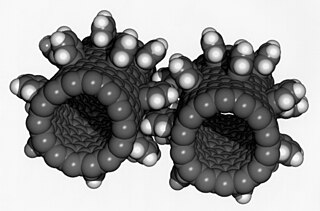
Nanotechnology is the manipulation of matter with at least one dimension sized from 1 to 100 nanometers (nm). At this scale, commonly known as the nanoscale, surface area and quantum mechanical effects become important in describing properties of matter. This definition of nanotechnology includes all types of research and technologies that deal with these special properties. It is common to see the plural form "nanotechnologies" as well as "nanoscale technologies" to refer to research and applications whose common trait is scale. An earlier understanding of nanotechnology referred to the particular technological goal of precisely manipulating atoms and molecules for fabricating macroscale products, now referred to as molecular nanotechnology.
Nanomedicine is the medical application of nanotechnology. Nanomedicine ranges from the medical applications of nanomaterials and biological devices, to nanoelectronic biosensors, and even possible future applications of molecular nanotechnology such as biological machines. Current problems for nanomedicine involve understanding the issues related to toxicity and environmental impact of nanoscale materials.

Nanomaterials describe, in principle, chemical substances or materials of which a single unit is sized between 1 and 100 nm.

A nanoparticle or ultrafine particle is a particle of matter 1 to 100 nanometres (nm) in diameter. The term is sometimes used for larger particles, up to 500 nm, or fibers and tubes that are less than 100 nm in only two directions. At the lowest range, metal particles smaller than 1 nm are usually called atom clusters instead.

Nanochemistry is an emerging sub-discipline of the chemical and material sciences that deals with the development of new methods for creating nanoscale materials. The term "nanochemistry" was first used by Ozin in 1992 as 'the uses of chemical synthesis to reproducibly afford nanomaterials from the atom "up", contrary to the nanoengineering and nanophysics approach that operates from the bulk "down"'. Nanochemistry focuses on solid-state chemistry that emphasizes synthesis of building blocks that are dependent on size, surface, shape, and defect properties, rather than the actual production of matter. Atomic and molecular properties mainly deal with the degrees of freedom of atoms in the periodic table. However, nanochemistry introduced other degrees of freedom that controls material's behaviors by transformation into solutions. Nanoscale objects exhibit novel material properties, largely as a consequence of their finite small size. Several chemical modifications on nanometer-scaled structures approve size dependent effects.
As the world's energy demand continues to grow, the development of more efficient and sustainable technologies for generating and storing energy is becoming increasingly important. According to Dr. Wade Adams from Rice University, energy will be the most pressing problem facing humanity in the next 50 years and nanotechnology has potential to solve this issue. Nanotechnology, a relatively new field of science and engineering, has shown promise to have a significant impact on the energy industry. Nanotechnology is defined as any technology that contains particles with one dimension under 100 nanometers in length. For scale, a single virus particle is about 100 nanometers wide.

Nanometrology is a subfield of metrology, concerned with the science of measurement at the nanoscale level. Nanometrology has a crucial role in order to produce nanomaterials and devices with a high degree of accuracy and reliability in nanomanufacturing.
Magnetic nanoparticles (MNPs) are a class of nanoparticle that can be manipulated using magnetic fields. Such particles commonly consist of two components, a magnetic material, often iron, nickel and cobalt, and a chemical component that has functionality. While nanoparticles are smaller than 1 micrometer in diameter, the larger microbeads are 0.5–500 micrometer in diameter. Magnetic nanoparticle clusters that are composed of a number of individual magnetic nanoparticles are known as magnetic nanobeads with a diameter of 50–200 nanometers. Magnetic nanoparticle clusters are a basis for their further magnetic assembly into magnetic nanochains. The magnetic nanoparticles have been the focus of much research recently because they possess attractive properties which could see potential use in catalysis including nanomaterial-based catalysts, biomedicine and tissue specific targeting, magnetically tunable colloidal photonic crystals, microfluidics, magnetic resonance imaging, magnetic particle imaging, data storage, environmental remediation, nanofluids, optical filters, defect sensor, magnetic cooling and cation sensors.

Core–shell semiconducting nanocrystals (CSSNCs) are a class of materials which have properties intermediate between those of small, individual molecules and those of bulk, crystalline semiconductors. They are unique because of their easily modular properties, which are a result of their size. These nanocrystals are composed of a quantum dot semiconducting core material and a shell of a distinct semiconducting material. The core and the shell are typically composed of type II–VI, IV–VI, and III–V semiconductors, with configurations such as CdS/ZnS, CdSe/ZnS, CdSe/CdS, and InAs/CdSe Organically passivated quantum dots have low fluorescence quantum yield due to surface related trap states. CSSNCs address this problem because the shell increases quantum yield by passivating the surface trap states. In addition, the shell provides protection against environmental changes, photo-oxidative degradation, and provides another route for modularity. Precise control of the size, shape, and composition of both the core and the shell enable the emission wavelength to be tuned over a wider range of wavelengths than with either individual semiconductor. These materials have found applications in biological systems and optics.
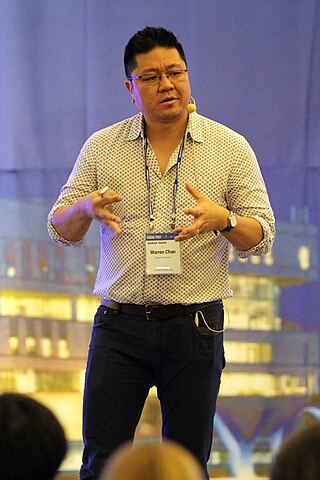
Professor Warren Chan is the Dean of the College of Engineering at Nanyang Technological University (NTU) in Singapore. Prior to that, he was a full professor at the Institute of Biomedical Engineering and Terrence Donnelly Centre for Cellular and Biomolecular Research at the University of Toronto. He received his B.S. and PhD degree, and post-doctoral training from the University of Illinois, Indiana University, and University of California, San Diego.
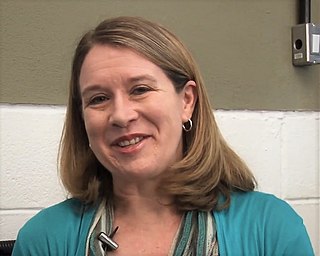
Christy Lynn Haynes is a chemist at the University of Minnesota. She works at the interface of analytical, biological, and nanomaterials chemistry.
Delia J. Milliron is the T. Brockett Hudson Professor in Chemical Engineering at the University of Texas at Austin. Milliron leads a research team that focuses on developing and studying the properties of new electronic nanomaterials. Her team pursues studies on nanocrystals, nanoscale interfaces, and controlled assemblies of nanocrystals. Her team takes a systematic approach towards elucidating effects that arise at the nanoscale with a special focus on structure-property relationships.

Sara E. Skrabalak is a James H. Rudy Professor at Indiana University. Skrabalak leads a research group in the department of chemistry which focuses on the development of new nanomaterials. She has an adjunct appointment in the department of intelligent systems engineering.

Nguyễn Thị Kim Thanh is a professor of Nanomaterials at University College London. She was awarded the 2019 Royal Society Rosalind Franklin Award for her research and efforts toward gender equality.
Uri Banin is an Israeli nanotechnologist and physical chemist and a professor at the Hebrew University of Jerusalem, currently holding the Alfred & Erica Larisch Memorial Chair at the Institute of Chemistry. He is recognized as one of the pioneers of nanoscience in Israel.
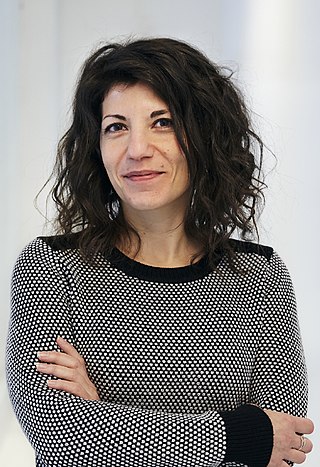
Raffaella Buonsanti (born 1981 in Matera, Italy) is an Italian chemist and material scientist. Her research is at the interface between materials chemistry and catalysis as she focuses on the synthesis of nanocrystals to drive various energy-related reactions, such as CO2 reduction. She is currently a tenure-track assistant professor at École Polytechnique Fédérale de Lausanne (EPFL) and director of the Laboratory of Nanochemistry for Energy located at EPFL's Valais campus.
Yayuan Liu is a Chinese-American materials scientist at the Massachusetts Institute of Technology. Her research considers electrochemistry, nanomaterials, and materials characterisation for the development of next-generation batteries. She was selected as one of the 2019 American Chemical Society Young Investigators and included in the 2021 Forbes 30 Under 30 list of top scientists.
Emilie Ringe is an American chemist who is an assistant professor at the University of Cambridge and a Fellow of Gonville and Caius College. She was selected by Chemical & Engineering News as one of its "Talented Twelve" young scientists in 2021.
Katherine B. Holt is a British chemist who is a professor at University College London. She serves as Vice Dean for Education in the Department of Mathematics and Physical Sciences. Her research investigates the development of carbon-based electrodes and electrocatalysis.
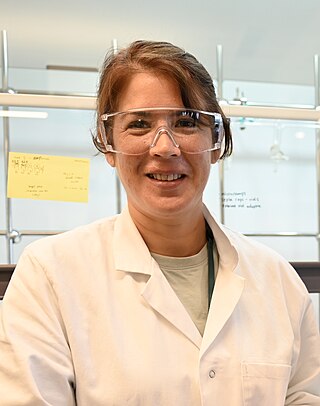
Christine Luscombe is a Japanese-British chemist who is a professor at the Okinawa Institute of Science and Technology. Her research investigates polymer chemistry, organic electronics, organic photovoltaics and the synthesis of novel materials for processable electronics. She serves on the editorial boards of Macromolecules, Advanced Functional Materials, the Annual Review of Materials Research and ACS Applied Materials & Interfaces.
References
- 1 2 3 "Author page T. Pellegrino". IEEE . Retrieved 2022-04-06.
- ↑ Francesco (2017-01-04). "Teresa Pellegrino". Women&Technologies - Associazione Donne e Tecnologie (in Italian). Retrieved 2022-04-06.
- ↑ "Professor Teresa Pellegrino joins the Associate Editor team – Nanoscale & Nanoscale Advances Blog" . Retrieved 2022-04-06.
- ↑ "European Research Council awards €3 million to Teresa Pellegrino's cancer project". iiTalk. 2022-03-17. Retrieved 2022-04-06.
- ↑ "L'Erc premia con 3 mln il progetto di Teresa Pellegrino dell'IIT". Askanews (in Italian). 2022-03-18. Retrieved 2022-04-06.
- ↑ "Emerging Investigators 2012". pubs.rsc.org. Retrieved 2022-04-06.
- ↑ "Ricerca, l'Europa premia undici progetti "pionieristici" made in Italy". Corriere dell'Università (in Italian). 2022-03-17. Retrieved 2022-04-06.